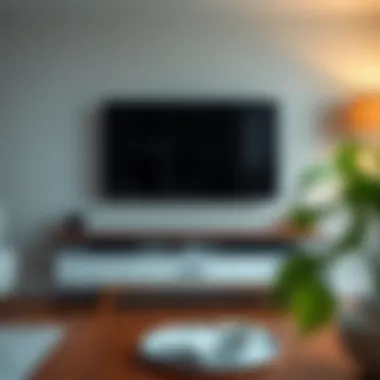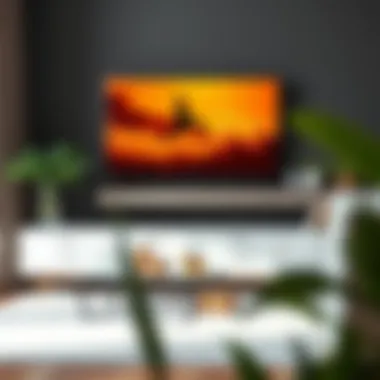Selecting the Perfect TV Table for a 32-Inch TV


Intro
Choosing the right TV table for your 32-inch television can sometimes feel like hunting for a needle in a haystack. With various factors to consider including aesthetics, functionality, and practicality, it’s no walk in the park. A TV table doesn’t just hold your television; it serves as a centerpiece in your living space, often reflecting your style and offering essential storage solutions. In this guide, we will navigate the winding path of selecting an ideal table, exploring niche details that can make all the difference between a haphazard setup and a well-coordinated look.
Furniture Styles and Trends
When it comes to TV tables, styles are diverse, and understanding current trends can steer you in the right direction. Let’s dig deeper into a couple of prevailing styles.
Modern vs. Traditional: Understanding the Aesthetics
Modern furniture often embraces minimalism, featuring clean lines and organic shapes. Think sleek MDF finishes and a touch of metal accents. On the other hand, traditional styles lean towards classic wood grains, ornate designs, and a warm color palette. A traditional table might have intricate carvings or a distressed finish that echoes an old-world charm.
However, it’s not a black-and-white situation. Hybrid styles have emerged, combining elements from both to create unique pieces that cater to various tastes. If your space has a contemporary flair, a modern table might be your go-to. Conversely, if your home tells a story of elegance and history, a traditional piece might harmonize beautifully.
Color and Material Trends: What's In and What's Out
The current color palette leans towards earthy tones, muted greens, and warm beiges. These colors exude calmness and serenity. In terms of materials, wood remains a staple, but its role is evolving. You may now find tables made from alternative materials like bamboo or repurposed wood that offer durability and a green option.
"Your choice of color and material doesn’t just speak to your taste; it shapes the ambiance of your room."
Also popular are glass and metal combinations, providing an airy feel, especially in smaller living spaces. By staying mindful of what’s currently fashionable, you can ensure that your TV table doesn’t become a relic too soon.
Furniture Care and Maintenance
Once you've chosen your ideal table, understanding how best to care for it helps maintain its longevity.
Tips for Prolonging the Life of Your Furniture
- Dust regularly: A soft, dry cloth can prevent dirt and grime buildup.
- Use coasters: Protect surfaces from heat and moisture by placing coasters underneath drinks.
- Avoid harsh chemicals: Gentle soaps and warm water work wonders, but steer clear of abrasive cleaners.
DIY Repair Hacks for Common Furniture Issues
Over time, even the most quality furniture can face issues. Here are some simple DIY hacks:
- Scratches on wood: A mixture of vinegar and olive oil can often conceal them effectively.
- Loose legs: A bit of glue can tighten up loose furniture legs without a hassle.
Staying on top of these small tasks can enhance not only the lifespan of your furniture but also its beauty.
End
Selecting the ideal TV table is no trivial matter. There’s much to ponder from the style and color to maintenance. By approaching your choice with knowledge and insight, you can find a TV table that not only fits your 32-inch television but also enriches your living environment. Each consideration is a building block towards creating a stylish and functional space that feels just right.
Understanding TV Tables
When it comes to setting up a living space, especially in relation to entertainment, the choice of a TV table holds significant importance. It's not just about having a place to set your television; the right TV table can enhance the overall aesthetic and functionality of a room. Understanding the various elements involved in selecting a TV table is essential for homeowners and enthusiasts alike.
Definition and Purpose
A TV table, simply put, is a piece of furniture designed to support a television set. It's typically more than a flat surface. Many designs incorporate additional features such as shelves, compartments, and even drawers. These elements serve multiple purposes: they provide a designated space for audiovisual equipment, help organize media accessories like remotes or game consoles, and can even store DVDs or books, depending on the design.
The purpose of a TV table is to serve as a practical solution for viewing comfort while ensuring that different components of your entertainment setup are kept tidy. For a 32-inch television, the right table can make all the difference in terms of display and accessibility.
Importance of TV Tables in Living Spaces
TV tables are far from being mere functional add-ons; they serve as a focal point in living spaces. Choosing the appropriate table for your TV has a profound effect on the room's atmosphere. Consider the following:
- Aesthetic Appeal: The style of the TV table can dramatically influence the overall decor. For instance, a sleek modern design can lend a contemporary feel, while a rustic wooden table may evoke coziness and warmth.
- Organization and Clutter Management: With built-in storage options, TV tables help maintain organization in living areas. This is beneficial in smaller spaces, where every inch counts. No one wants a pile of cords and electronics laying around—having a dedicated spot for these items keeps things neat and visually appealing.
- Ergonomics and Viewing Experience: Height and angle are crucial for enjoyable viewing. A properly chosen TV table can elevate your screen to the correct height, promoting good posture during long viewing sessions. This little detail may seem insignificant, but it impacts your overall comfort while watching.
In summary, understanding TV tables is about acknowledging their multifaceted role in your living environment. They are not merely objects of utility, but rather integral components that combine function and form. This understanding lays the foundation for making a well-informed choice when selecting the ideal TV table for a 32-inch television.
Dimensions and Specifications for a 32-Inch TV
When selecting a TV table, particularly for a 32-inch television, dimensions and specifications play a crucial role. This section delves into a few key aspects that can make or break your choice. An ill-fitting table can ruin your living space's balance, whereas a well-considered selection enhances both function and aesthetic appeal. The right table complements the television while providing essential support and creative storage solutions.
Optimal Size for a TV Table
Finding the right size for your TV table is more than just a matter of aesthetics; it affects the viewing experience as well. A table that is too small can appear dwarfed next to your television, while one that is excessively large can overwhelm the space, creating imbalance. The standard recommendation for a 32-inch TV is a table that ranges between 42 to 50 inches in width. This width offers ample space for the television and leaves room for decorative elements like picture frames or plants.
Moreover, the height of the TV table should ideally be between 24 to 30 inches to align with the average eye level of viewers who sit on sofas or chairs. This height consideration is vital in allowing for an optimal viewing angle. Placing the television too high or too low can lead to neck strain.


It's also advisable to have at least a foot of clearance from the bottom of your TV to the surface upon which it sits. This space not only allows for air circulation to prevent overheating but also offers room for sound bars or other equipment. In summary, when it comes to sizing, going for a table that respects these dimensions will enhance both the function and look of your room.
Weight Considerations
Weight is another key factor to consider when choosing a TV table for your 32-inch television. The weight of the TV will determine the sturdiness required in the table's design. Generally, a 32-inch television weighs around 20 to 30 pounds, depending on the make and model. Therefore, it's imperative to choose a table that can support this weight comfortably.
When examining tables, consider the following:
- Construction Material: Heavier materials like solid wood will often provide better stability for your TV, while lighter constructions, such as particle board, may suffice but can jeopardize long-term stability.
- Design Integrity: Ensure the legs and frames have enough thickness and strength to hold the television without bending or warping over time.
- Weight Capacity: Always check the manufacturer's specifications for weight limits to confirm that it can safely support not just the TV but also any additional components that might be placed on the surface.
A sturdy base contributes significantly to the overall stability of your setup. You wouldn't want your display to be at risk just because you opted for a flimsy table, right? In essence, choosing a table designed to handle a bit more than your TV's weight will leave you with peace of mind.
"A sturdy base is not just about aesthetics; it's about ensuring the longevity and safety of your tech investments."
Materials Used in TV Table Construction
Choosing the right materials for a TV table is no small feat. The material defines not just the aesthetics but also the durability and functionality of the piece. It’s important to consider how materials can enhance the living space while meeting specific needs. Each type of material brings its own advantages and downsides, making it crucial to understand these elements thoroughly.
Wood: Types and Benefits
Wood is a classic choice that brings warmth and character to any room. It's not just about looks, though. Different types of wood offer various benefits. For instance, solid oak is known for its durability, resistant to wear and tear. On the flip side, pine may come at a lower price but can be less sturdy and more susceptible to scratches.
Moreover, wood finish plays a significant role. High-gloss finishes may elevate a contemporary aesthetic, while matte finishes can provide a rustic touch. Additionally, wood can easily be painted or stained, allowing flexibility for personal taste adjustments.
- Benefits of Wood:
- Durability: Solid constructions last longer with proper care.
- Aesthetic Appeal: The grain patterns add uniqueness.
- Versatility: Can match various decor styles, from traditional to modern.
Metal Frames and Components
Metal has increasingly found its way into TV table design. Often used in the form of frames or accents, it introduces an industrial vibe that pairs well with wood or glass elements. Steel and aluminum are common choices that stand the test of time, showcasing strength without being overly bulky.
The beauty of metal lies in its sleek look and the ability to incorporate functionality like adjustable height features or easy-to-move structures. These frames can often bear significant weight, accommodating heavier components, which is especially useful if one sets up a gaming console or sound system nearby.
- Benefits of Metal Components:
- Strength: Heavy-duty support for equipment.
- Sleekness: Adds a modern aesthetic.
- Low Maintenance: Less likely to scratch compared to wood.
Glass Elements in Design
Glass can add a level of sophistication that other materials simply can't. Using tempered glass for shelves or tabletops not only creates a light and airy feel but also allows for the showcasing of decorative elements. A glass top table, for example, can make a small room appear larger.
There’s practicality in glass too; it's easy to clean and can resist scratches if treated properly. But, keep in mind that glass can be heavy and might not be the best choice for families with young kids or pets, as it can break more easily than other materials.
- Advantages of Glass:
- Elegance: Elevates design and style.
- Visibility: Showcases decorative items beneath it.
- Easy Maintenance: Simple cleaning with a glass cleaner.
It's clear that the material choice for a TV table goes beyond mere function. The right blend can create a harmonious balance between style and usability, helping to set your home's tone and comfort.
When making a decision, weigh your lifestyle against the materials' properties. Whether you favor the warmth of wood, the robustness of metal, or the elegance of glass, each option presents unique opportunities to enhance your space.
Design Styles for TV Tables
When selecting a TV table, the design style plays a pivotal role in defining not just functionality but the entire aesthetic of your living space. With a well-chosen design, a TV table can enhance your room’s atmosphere, making it feel more cohesive and inviting. Whether you're aiming for sleek sophistication or cozy warmth, understanding the prevalent styles helps narrow down choices that align with both personal taste and home décor.
Modern Minimalist Aesthetics
The modern minimalist style is all about clean lines, functionality, and simplicity. A TV table that embraces this aesthetic tends to avoid ornate decorations and instead focuses on the essentials. This design often incorporates materials like metal and glass, providing a sturdy yet airy feel.
Here are a few key benefits of opting for a modern minimalist TV table:
- Clutter Reduction: The simple design naturally discourages clutter, making your space appear more spacious and organized.
- Versatility: Minimalist tables can seamlessly fit into various decor styles, from contemporary to eclectic, offering a blank canvas to complement other elements.
- Easier Maintenance: With fewer intricate features, cleaning a minimalist table is often a breeze.
For those drawn to the 'less is more' philosophy, a modern minimalist TV table without excessive frills is a polished addition to any home.
Classic and Traditional Designs
Classic and traditional designs evoke a sense of timelessness and heritage. These TV tables often feature rich woods, intricate carvings, and warm finishes that add character and charm to the room.
Benefits of choosing a classic design include:


- Timeless Appeal: A traditional table withstands trends and aging, ensuring it remains stylish for years to come.
- Sturdy Build: Typically constructed from solid wood, these tables provide durability and stability, making them able to hold more weight than their modern counterparts.
- Warmth and Character: Traditional furniture adds warmth to your space, making it feel inviting and lived-in.
Ultimately, a classic TV table can become a focal point, speaking volumes about the owner's taste while serving its primary function.
Rustic and Industrial Influences
The rustic and industrial look marries raw materials with a touch of charm. This style often features reclaimed wood and metal accents, creating a rugged yet stylish appearance. The blend of textures offers a unique character that sets it apart.
Choosing a rustic or industrial TV table can come with several perks:
- Unique Aesthetic: Each piece often tells a story through the materials used, ensuring your furniture remains unique.
- Durability: The robust materials tend to be less susceptible to wear, making them ideal for busy households or odd use.
- Eclectic Pairings: Rustic elements can mix with modern or traditional decor, allowing for creative and versatile styling.
Incorporating a rustic or industrial TV table into your home can create an exciting visual dialogue, allowing even the simplest of spaces to feel more dynamic.
Choosing the right design style for your TV table is as essential as picking the TV itself. It’s about harmonizing functionality with personal aesthetics, thus creating a welcoming environment for family and friends.
Storage Solutions and Features
When delving into the selection of a TV table, particularly for a 32-inch television, the aspect of storage solutions and features cannot be overlooked. Storage is not merely about stowing things away; it directly influences the functionality and overall look of your living space. A well-designed TV table can optimize your entertainment area, allowing for an organized setup while enhancing aesthetic appeal. The right storage choices help to minimize visual clutter, keeping your area both tidy and welcoming.
Shelves and Compartments
Incorporating shelves and compartments into your TV table design can do wonders for both functionality and style. These elements act as dedicated spaces for your media devices – be it your cable box, gaming console, or Blu-ray player.
- Open Shelving: This type of component is trendy as it creates an airy feel. Think of multiple levels of open space where your devices can rest. It allows for easy accessibility and quick equipment changes, making it a favorite among many homeowners.
- Enclosed Compartments: For those who prefer a more polished look, closed storage units can hide away the mess. Imagine a cabinet-style setup that keeps your devices safe from dust while still being easily accessible when needed. This feature is particularly engaging for those who appreciate a clean aesthetic.
With both types, consider the depth and height of the shelves. Ideally, everything should fit comfortably without cramping your style.
Cable Management Systems
In today's tech-laden world, managing cords can feel like an uphill battle. This is where cable management systems shine in your TV table selection. Having a clutter of wires visibly snaking across your living area can be an eyesore, detracting from the intended elegance of your setup.
- Built-in Cable Management: Look for tables with integrated systems that allow you to neatly organize and hide those bothersome cables. These features can come in forms like cable clips, back panels with holes, or even trays that catch any loose cables beneath the table.
- External Solutions: Don't shy from external accessories either. Options such as cable sleeves or decorative boxes can add an extra layer of organization while harmonizing with your room's decor.
This attention to detail not only maintains the aesthetic of your entertainment center but also enhances safety by preventing tripping hazards.
Additional Functionality
The modern consumer is on the lookout for more than just a surface to hold a TV. Additional functionality is now an expectation rather than a bonus.
- Multi-purpose Tables: Some TV tables now serve dual purposes, functioning as media centers or even storage benches. Picture a table that not only holds your television but also provides extra seating or serves as a spot to showcase some family photos or art.
- Modular Designs: The modular approach is another trend worth mentioning. With this design, components can be rearranged based on your needs. Whether you're hosting a movie night or simply looking to change things up, a modular unit offers unrivaled versatility.
Remember: The best table for your needs aligns with your lifestyle and aesthetic preferences. Don’t hesitate to balance utility with style for a final setup that feels personalized and complete.
In summary, the storage solutions and features of your TV table are pivotal in shaping both the utility and visual harmony of your space. By carefully considering the elements of shelves, cable management, and additional functionality, you can create a living area that not only functions well but reflects a sense of order and style. Each decision you make contributes to how comforting and pleasing your entertainment zone feels.
Considerations for TV Table Placement
Choosing the right location for your TV table is as crucial as selecting the table itself. Proper placement can significantly enhance your viewing experience and contribute to the overall harmony of your living space. Here are several key aspects to think about regarding the placement of your TV table.
Viewing Heights and Angles
Determining the optimal height for your TV table is a top priority when setting up your space. The ideal height ensures that your television is at eye level when seated, which helps reduce neck strain and enhances your viewing comfort. When you sit down to watch your favorite shows or movies, you want your screen to be perfectly aligned with your line of sight.
- Eye Level Measurement: Generally, the center of the screen should align with your eyes when you are in the seated position. If your couch is about 18 inches off the ground, a TV table with a height between 24 to 30 inches works well for most viewers.
- Tilt and Position: Take into account whether your TV has a tilt or swivel capability. If so, slight misalignment in height might be acceptable. Just be cautious, as this could lead to reflections and glare, especially if your living room is well-lit.
- Room Dimensions: The size of your room also plays a significant role. In a compact area, a lower TV table might make space feel larger. Conversely, in an expansive living room, a taller table could provide a more balanced visual structure.
"When it comes to viewing heights, finding that sweet spot is key to an enjoyable TV experience."
Proximity to Seating Arrangements
Another consideration is the distance between the seating arrangements and the TV table. This distance dictates not only comfort but also the quality of your viewing experience.
- Distance Guidelines: A typical rule of thumb is to sit at a distance from the screen that is about 1.5 to 2.5 times the diagonal size of the television. For a 32-inch TV, this means a seating distance of approximately 4 to 8 feet.
- Seating Type and Arrangement: Consider how your seating is positioned relative to the TV. For instance, sectional sofas might necessitate a different distance when compared to standard couches or chairs. Arranging your seating in a semi-circular formation often results in better visibility and a more immersive experience.
- Accessibility and Flow: Ensure that the layout allows easy movement throughout the room. You don’t want to be constantly dodging coffee tables or chairs. Stay mindful of furniture placement that facilitates smooth access to seating while maintaining a natural viewing distance.
In summary, precise placement of your TV table is essential. Taking the time to assess viewing heights and seating proximity can lead to a more enjoyable environment for you and your guests. By focusing on these elements, you can create a living space that combines comfort with functionality.
Assembly and Maintenance
When it comes to selecting a TV table for your precious 32-inch television, assembly and maintenance are not just afterthoughts. They are crucial aspects that can greatly influence your experience and satisfaction with the piece of furniture. Proper assembly ensures that your TV table stands firm and functions as intended, while maintenance dictates how long it stays aesthetically pleasing and operational. Taking time to understand these elements can save homeowners and DIY enthusiasts from future headaches and frustrations.
Assembly Instructions: What to Expect


As you prepare to set up your TV table, you’ll want to be aware of what lies ahead. Many TV tables come with assembly instructions that are often straightforward, though occasionally a bit muddled. It’s advisable to read through the instructions carefully before diving in. Look for key elements such as:
- Components and Tools Required: Check that all parts are included in the package. Commonly, you'll need basic tools like a screwdriver or an Allen wrench, which might sometimes be offered in the kit.
- Step-by-Step Guide: Most manufacturers provide an illustrated guide that outlines each step. Make sure to follow the order of assembly as suggested, which often prevents mistakes and future instability.
- Time Estimates: Some assembly jobs are quick, taking merely 30 minutes, while others may take a couple of hours. Keep this in mind to set aside adequate time.
One important note is to work in a spacious area to avoid bumping into walls or other furniture. Also, placing a soft cloth underneath can prevent scratches the table's surface.
Maintenance Tips for Longevity
Once your TV table is set up, you’ll want it to remain in prime condition for years to come. Maintaining it doesn’t require a degree in furniture care, but a few best practices can make a world of difference. Here are some vital tips to keep your table looking sharp:
- Regular Cleaning: Use a soft, slightly damp cloth to wipe down surfaces. Avoid harsh chemicals that can strip protective finishes. For wooden tables, a specialized wood cleaner can help maintain that rich look.
- Avoid Direct Sunlight: If possible, position your TV table away from direct sunlight. Over time, UV rays can cause fading that detracts from its appearance.
- Weight Limit Awareness: Each table has a recommended weight limit. Exceeding this limit not only risks damaging the furniture but can also pose safety hazards.
- Inspect for Stability: Periodically check all screws and connections. Loose fittings can lead to wobbling, which not only affects aesthetics but can also harm the TV if it falls.
"Taking just a few minutes each month to check and maintain your TV table can immensely extend its life and appearance."
Understanding how to assemble and maintain your TV table can greatly enhance your enjoyment of your living space. It makes all the difference between a mere piece of furniture and a lasting home accessory that supports your entertainment in style.
Budget Considerations
When it comes to selecting a TV table for your 32-inch television, budget considerations shouldn't be an afterthought. The financial aspect often directs the entire decision-making process, influencing everything from the materials used to the features included. By carefully analyzing your budget, you can strike a balance between quality and cost which ultimately enhances your viewing experience without breaking the bank.
Understanding how much you can spend on a TV table is crucial. It not only helps you avoid overspending but also narrows down your options to a more manageable list.
Price Range Analysis
The market presents a myriad of choices, and TV tables are no exception. You can typically find TV tables ranging from economical to extravagant prices. Generally, here’s how the price brackets look:
- Affordable Range: $50 - $150
You often find basic designs made from MDF or particle board in this range. While they may lack intricate details, they serve the fundamental purpose quite nicely. They might come without any bells and whistles but are plenty sturdy for a 32-inch television. - Mid-Range: $150 - $400
In this bracket, it's common to see a mix of wood and metal components, along with features like additional storage. These tables often feature contemporary designs but without a hefty price tag. - Premium Range: $400 and up
Here, you can expect high-quality materials such as solid wood or designer glass elements. Customizable features and elegant design aesthetics often characterize these tables. Investing in this range could provide enhanced durability and distinction within your living space.
The key is to identify what you require versus what is available within each price range. That makes it easier to weigh the pros and cons without feeling overwhelmed by the options.
Cost vs. Value Assessment
Thinking about cost shouldn't end at merely knowing the prices. Understanding the concept of value is equally important. To assess value realistically:
- Quality vs. Cost: Sometimes, paying a little bit more can mean a significant upgrade in quality. A well-constructed table can endure wear and tear over time, saving you money down the line. A cheaper option might appeal now but could lead to extra expenditures for replacements or repairs.
- Functionality: Does a particular table serve your needs? A more compact option may not offer the ample storage you require, which may prove inconvenient. Finding a balance between features and price pays off in the long run.
- Aesthetical Appeal: A TV table is a prominent part of your living space. While a cheaper table can save money, it might clash with your home decor. Consider spending on a table that ties in well with your overall design theme to boost your home's visual harmony.
In the end, a keen understanding of your budget and what you expect to get out of a TV table will lead to a more fulfilling purchase.
"Money may not buy happiness, but it sure does help to have a sturdy TV table that perfectly fits your television!"
By weighing both cost and value, you will not only make an informed decision but also feel satisfied with your investment.
Trends in TV Table Design
As we sink deeper into the era of stylish living spaces, choosing a TV table isn't just about functionality—it’s a statement piece. Trends in TV table design reveal how homeowners, designers, and enthusiasts alike are prioritizing not just practicality but also aesthetics, sustainability, and technology. These trends reflect a larger shift in consumer attitudes toward home furnishings, merging day-to-day usability with a flair for modern design.
Sustainability in Furniture Design
Sustainability has become more than just a buzzword; it's a pillar upon which many contemporary furniture choices are built. When selecting a TV table, it’s increasingly important to consider its environmental impact. People are gravitating towards pieces made with reclaimed wood, bamboo, or eco-friendly composites. These materials not only offer character and warmth but are also kinder to our planet.
- Benefits of Sustainable Materials:
- Reduced Carbon Footprint: Items made from recycled or sustainably harvested materials help reduce the demand on natural resources.
- Longevity: Many sustainable materials are built to last. Furniture made from solid woods or high-quality composites tends to endure longer, minimizing replacements.
- Healthier Home Environment: Avoiding harmful chemicals often found in processed woods or synthetic materials can lead to better indoor air quality.
However, one must also be vigilant about the certifications of the materials used. Look for labels like FSC (Forest Stewardship Council) certified wood to ensure that the environment responsibly sourced.
"Choosing sustainable furniture isn’t simply a trend; it’s an investment in the future—a form of data-driven style that pays homage to both environment and artistry."
Smart Furniture Solutions
As homes become smarter, the furniture that fills them adjusts accordingly. Smart furniture solutions are on the rise, integrating technology into standard designs. Imagine a TV table with built-in charging ports, Bluetooth speakers, or even cable management features that blend seamlessly into the overall design.
- Prominent Features:
- Charging Stations: No more scrambling for outlets or dealing with tangled cords. Smart tables come with integrated charging pads or USB ports, enhancing convenience.
- Adjustability: Some modern designs offer adjustable heights, allowing users to transform their furniture setup to cater to various activities—be it watching TV or working from home.
- Remote Controls: Certain tables come equipped with technology that allows you to control lighting or audio systems right from the furniture itself.
These innovations not only improve functionality but can also lead to a more organized living environment. Homeowners looking to purchase a TV table must therefore consider how technology can complement their lifestyle and space, ultimately enhancing their living experience.
Final Thoughts on Choosing a TV Table
Selecting the right TV table for your 32-inch television is not just about aesthetics; it’s a blend of functionality, personal style, and suitability for your living space. As we've journeyed through various aspects—from dimensions and materials to style trends—it becomes crucial to synthesize these points. A TV table isn’t merely a piece of furniture but rather a central entity in your living room that can enhance or detract from the overall ambiance.
Key Takeaways
In considering what to take away from this guide, a few core points stand out:
- Size Matters: Ensure the TV table fits not just the TV but complements the space and allows for comfortable viewing angles. Opt for a height that aligns well with your seating arrangements to avoid neck strain while watching your favorite shows.
- Material Selection: Choose materials that resonate with the rest of your home décor. Whether it’s sturdy wood for warmth or sleek metal for a modern vibe, the right material can speak volumes about your style preferences.
- Storage is Key: Look for options that offer clever storage solutions. In a world where clutter can creep up on you, having integrated shelves and compartments can keep your entertainment area neat and tidy.
- Aesthetic Appeal: Consider the design style that reflects your personality—be it modern minimalist, rustic charm, or classical elegance. Your taste should shine through.















